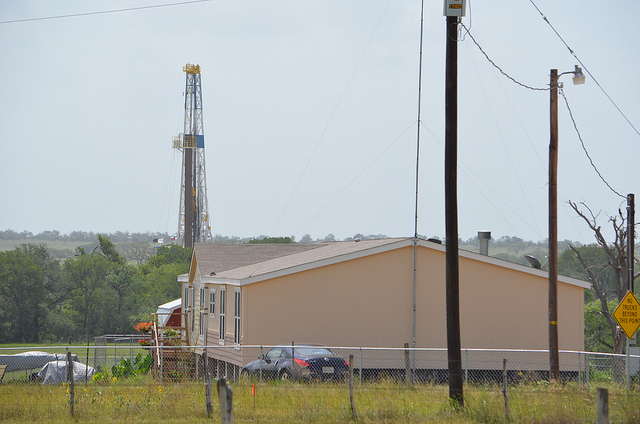Podcast: Play in new window | Download
Subscribe: RSS

Coming soon to a yard near yours? A fracking well looms over a residence in the Eagle Ford shale region of Texas. (Photo by Earthworks Action/Flickr)
The headlines are coming with dizzying speed. On October 11, “US Soon to Overtake Russia as World’s Largest Oil Producer.” And then days later, “US Surges Past Saudis to Become World’s Top Oil Supplier.” Wait, how can Russia and Saudi Arabia both be the world’s largest oil producer in the same week? Okay, never mind, they run neck and neck. So this is really great news for American oil burners, no reason at all now they should change their planet-warming ways. If the headlines were true. Which they weren’t.
It is not only that the headlines lied about reality, they lied about the content of the stories atop which they squatted. If you read all the stories, to the very bottom, they will tell you that, actually, they were not talking about oil, exactly, but about a category they call “petroleum liquids,” which includes natural gas, biofuels, ethanol, distillates, refinery gains and the flop sweat collected from speakers at peak-oil conferences. I made only one of those up.
For those of us who choose to linger in the un-altered reality where oil is black stuff found underground, where true is different from not true, and where two plus two always equals four, the situation hasn’t changed much at all. [All the numbers that follow are from the US Energy Information Agency at www.eia.gov]
Russia and Saudi Arabia continue to fill just under 10 million barrels a day with crude oil while the US, this year, will probably reach 7.5 million bpd. It is true that for America this is a gain of a full million barrels per day over 2012. But it is still not true that 7.5 million is more than 10 million. And it is still true that the US burns nearly 20 million barrels per day (I’m using round numbers here, consumption is down to 18.55 million bpd as a result, mostly, of the Great Recession, but there is little reason to think that it won’t rebound if the economy does).
Therefore, our implacable friend Arithmetic says, we would have to triple current production to achieve energy independence, another term being tossed around by oil boosters and landing in headlines these day.
Now, it is true that US oil production has risen dramatically in the past two years, due mainly to the application of large scale hydraulic fracturing in oil shale fields in North Dakota and Texas. Just a few years into this “boom” some inconvenient facts have come to our attention:
-
the depletion rate of fracking wells is astonishing — 30 to 40 per cent a year. This means that, just to maintain production let alone grow it, you have to replace each fracking well with another every two or three years. This insatiable need for investment explains, all by itself, the volume of the hype about the glorious future of oil and America.
-
the expense of operating fracking wells is higher than predicted.
-
it is becoming more difficult and more expensive every year to find and deliver the enormous quantities of water needed to frack a well.
-
that water, once used, is riddled with toxic chemicals (plus, it turns out, high levels of radioactivity) and either has to be treated — something not many existing plants are equipped to do — or put somewhere “safe,” like deep underground. Right. What could be safer than billions of gallons of toxic water blindly injected deep underground where it cannot be seen?
Desperate measures and frantic propaganda continue to prop up the oil-soaked industrial age, but cannot repeal the laws of nature and arithmetic. When all you do is subtract, pretty soon you get to zero.
“Flop sweat”. Yeah. That’s a good one Tom.
Thank you.